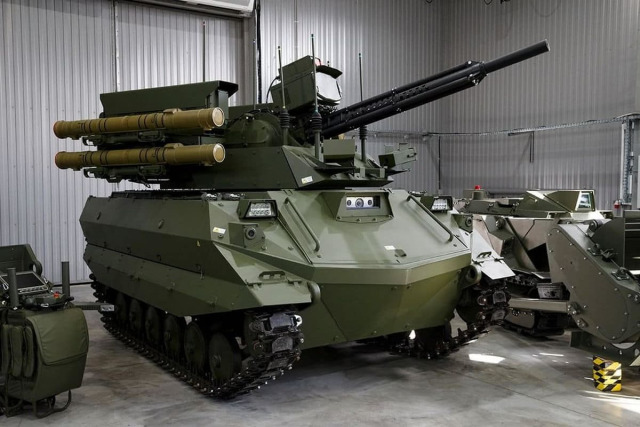According to Western analysts, the war in Ukraine has literally brought the issue of autonomy and artificial intelligence (AI) to the fore. Moreover, both belligerents seek and actually use various degrees of AI and autonomous operations. At the same time, in this war, the autonomy of ground equipment is still limited mainly by remotely controlled systems, which is explained by the very complex Ukrainian combat space, replete with means of counteraction. According to the author of the material proposed below, by May 2023 there was still no example of a real ground-based autonomous system used in direct combat, although some data from open sources suggested that some types of uninhabited ground-based robotic systems (RTCs) could already be used.

Samuel BENDETT
Below is an excerpt of the article "The State of Autonomy, AI and Ground Robotics in Russia" (The State of Autonomy, AI & Robotics for Russia's Ground Vehicles), which explores the state and development of Russian AI and robotic systems. The author is Samuel BENDETT – analyst, expert on Russian military autonomy and AI at the Department of Defense's Defense Systems Information Analysis Center
Russian ground-based robotic systems in practice
As of 2023, Russian military developers have created many combat and auxiliary unmanned systems, including Platform-M, Nerekhta, Soratnik, Kungas, Whirlwind, Sturm, Marker, Uran-6, Uran-9,Passage", "Scarab" and "Scorpion" and others. By May 2023, some of them were already used in Ukraine as remote-controlled systems, while the operator was under reliable control and in relative proximity to the RTK itself. In July 2022, the Russian military tested the robotic complex "Passage-1" in the Ukrainian region of Donbass for the neutralization of mines and unexploded ordnance (UXO). The Russian Defense Ministry also noted that the "Pass-1" was tested in Syria together with the "Uranium-6". Russian military sappers used the Cobra-1600 RTK in Ukraine to conduct reconnaissance and detect unexploded mines, rocket fragments and improvised explosive devices. The Russian military also uses Uran-6 mine-clearing machines to clear large areas of UXO in the Donbas and southern Ukraine.
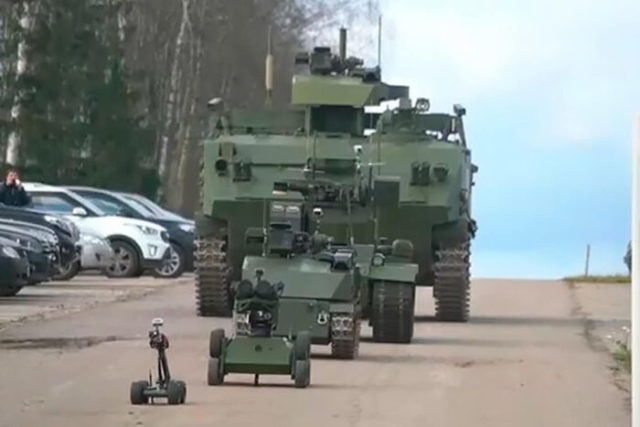
The family of RTK "Kungaz"
In April 2022, Russia pledged to begin combat tests of the heavy assault military robot "Sturm", designed primarily for urban combat, which is being created on the basis of the T-72. It is unclear whether the tests, which included firing at targets from a 125 mm cannon, were actually carried out, given the lack of subsequent media coverage. The same can be said about most of the RTK projects mentioned above. After the initial testing of the RTC "Kungaz", "Whirlwind", "Nerekhta" and "Companion" were either designated as test platforms for subsequent developments, or the Russian media fell silent about their further development. At the moment, the biggest questions that arise in connection with the development of combat robotic complexes by Russia are their absence on the front line in the current war.
This absence is most likely due to the 2018 Uran-9 stress tests that were conducted in Syria. After a comprehensive analysis of the failures of Uran-9, the Russian Ministry of Defense indicated that over the next 10-15 years, one-time and preferably stationary use of RTCs is probably the most viable approach to their use. Examples include "one-time" attacks or "kamikaze" attacks against enemy fortified points and fixed targets. The ultimate combat mission of the current generation of RTK is to be a consumable material as an addition to other systems, forces and units.
Logistical and human difficulties associated with the attempt to restore damaged or destroyed robotic systems should outweigh the costs of their production and development. Therefore, in the directives of the Ministry of Defense of the Russian Federation after Uran-9, it was proposed to use such combat vehicles with other military formations and never by themselves, since their breakdown would negatively affect the speed and effectiveness of the military mission. In 2019-2020, the Russian military took delivery of a limited number of the Uran-9 RTK, presumably for testing and evaluation, but this was probably postponed due to the allocation of human and material resources for the war in Ukraine.
RTK "Uran-9" before the parade on May 9, 2019 in Moscow
The Russian Defense Ministry's wish list for military robots includes autonomy for faster decision-making, especially in a rapidly changing urban combat environment. Some Russian military experts believe that, based on the current development of AI technologies, fully autonomous combat systems capable of independently searching for targets may appear in a few decades. The key characteristics of unmanned and autonomous ground combat operations should include maximum unification, modularity, versatility, compatibility with various systems and the ability to integrate into existing and future military formations. Such platforms should ensure the exchange of information between unmanned vehicles as part of a mixed group or swarm of various ground and air assets and vehicles, including those with piloting systems (MUM-T), and be resistant to countermeasures.
Practical combat use of RTK
Dmitry ROGOZIN, the former director of Roscosmos currently working in Donbass, announced in February 2023 that he had accepted the delivery of several ground-based RTK Marker. He promised to start uploading images of targets and combat algorithms to the combat control modules of the vehicle and install anti-tank weapons to possibly counter the M1 Abrams and Leopard 2 tanks supplied by the West. This marked the first appearance of a combat military robot in Ukraine, although questions remain as to why D. Rogozin, who is now a private individual, and not the actual Ministry of Defense was tasked with conducting this testing and evaluation.
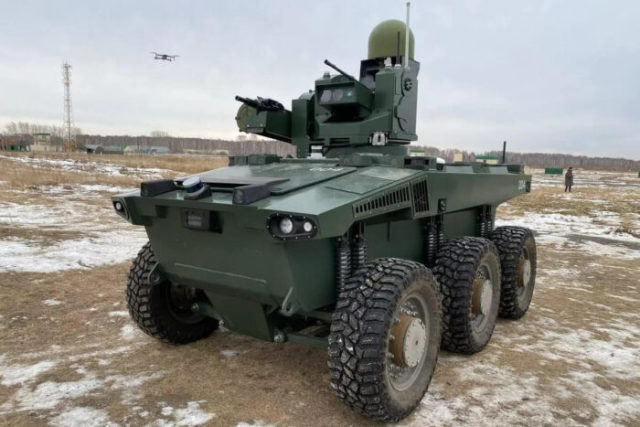
Wheeled RTK "Marker" with a small quadcopter
The Russian RTK "Marker" was developed jointly by the Foundation for Advanced Research (FPI, a Russian organization similar to DARPA) and Android Technologies, one of the largest Russian robotics developers. "Marker" is a testbed for autonomous, robotic AI technologies, such as computer vision, communication, navigation, autonomous movement and group control.
By the beginning of 2023, there were several tracked and wheeled versions, including a reconnaissance RTK with a tethered unmanned aerial vehicle (UAV) to improve reconnaissance and surveillance capabilities. In addition, there is a combat version that can be armed with anti-tank guided missiles (ATGM), automatic grenade launchers, machine guns and/or suspensions capable of transporting UAVs and ammunition.
The security version of the "Marker" is equipped with day and infrared cameras. Before the invasion in February 2022, the Marker was tested as a platform for fighting drones, as a means of protection against small UAVs that became so common during the war in Ukraine. There is also a logistics version of the "Marker" for cargo transportation and medical evacuation. D. Rogozin plans to test a combat version with ATGM, and to test the Marker's tethered drone as an intelligence platform, and the RTK will be hidden from potential Ukrainian countermeasures.
One of the key roles of the "Marker" is a coordinated autonomous action in conditions of uncertainty for the independent performance of tasks at a great distance from the operator using deep neural networks that help the vehicle to make decisions. The FPI also provides for the training of the "Marker" to human voice commands after testing voice control technology for a joint group of manned and unmanned systems. Marker's technical solutions, such as AI, machine vision and group control, can potentially be scaled to the level of a large tank or other uninhabited ground vehicles. This hints at possible plans for the future if this military robot passes the stipulated tests in Ukraine.
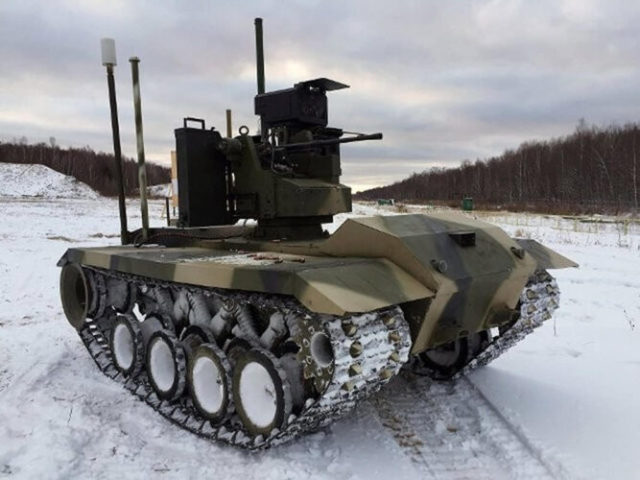
RTC "Nerekhta" during winter tests
The developers of the "Marker" in 2021 conducted an experiment with several devices that independently moved through a wooded area to a pre-selected destination. D. Rogozin's test plans include "Markers", presumably distinguishing enemy vehicles in combat using data sets. It is unclear whether such data sets will come from FPI and/or Android Technologies, or D. Rogozin's organization will be able to purchase them elsewhere. There are Russian companies working on similar image recognition mechanisms for military intelligence UAVs with AI support.
The last statement concerns neural network training algorithms for identifying NATO military equipment in a variety of environmental conditions, including short exposure times. These data can potentially help in testing "Markers", assuming that D. Rogozin will be able to obtain such data sets.
It is unclear whether D. Rogozin's experiment will include:
- a fully remote-controlled version of the "Marker" to mitigate the effects of complexity and uncertainty on the battlefield in Ukraine;
- the "man in a loop" approach, in which the "Marker" moves autonomously, and the operator makes the final decision about choosing a target and terminating the action, or
- the "man in a loop" approach, in which the "Marker" independently selects and decides which targets to hit, and the operator gives final approval.
It is likely that the intelligence version of the "Marker" is best suited for Ukraine. It will include a tethered-control drone operating via a power cable at an altitude of 150 m. RTK will be able to launch the UAV while in hiding to avoid detection. This will allow the car to "see" at a distance of 15-20 km, which guarantees the possibility of key observation of the battlefield and situational awareness. If both of the claimed tests prove unsuccessful, the RTK can be used as an integrated stationary gun platform, which is a plausible tactic indicated by the Russian Defense Ministry's review of the effectiveness of the Uran-9 in Syria.
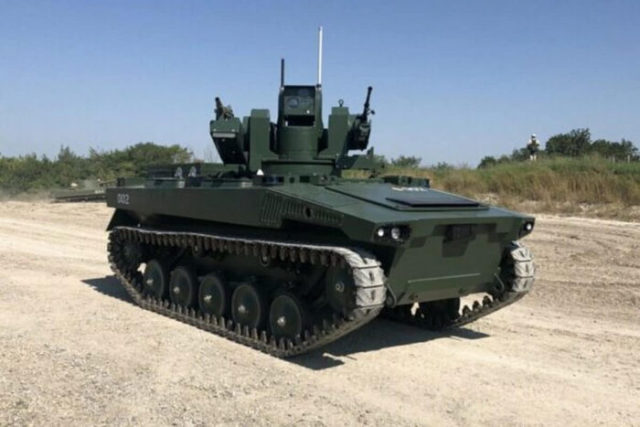
Crawler RTK "Marker"
Is it possible to move forward with the help of RTK?
Following the actions of the Russian military in Ukraine, some Russian military observers have put forward ideas for the potential improvement of tank and ground combat operations. In June 2022, Viktor Murakhovsky, the editor-in-chief of the highly respected Russian magazine Arsenal of the Fatherland, suggested that the main direction of improving the performance of the tank is situational awareness and combat control. V. Murakhovsky suggests equipping the tank with micro-drones that will operate within a line of sight, up to 4-5 km, at a range where enemy ground forces tend to concentrate. This will allow you to more accurately direct tank shells at targets and avoid detection.
... As another promising direction for the development of tank warfare, V. Murakhovsky noted the gradual automation and robotization of combat processes inside the tank and the reduction of the crew. He expressed the opinion that in the near future, mixed formations consisting of tanks with crew and uninhabited vehicles may enter the battlefield. In this scenario, remotely controlled robotic tanks could become the front offensive echelon for reconnaissance, security and other tasks instead of modern manned tanks.
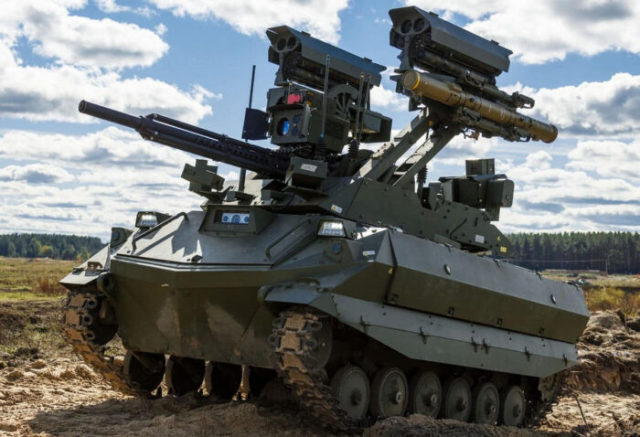
RTK "Uran-9" during the tests
While in Syria, Uran-9 failed to cope with the roles that V. Murakhovsky prescribed for the future combat vehicle, Marker can once again try to prove whether such roles are technically feasible, given, first of all, the complexity of the Ukrainian battlefield and the presence of numerous countermeasures, which include many commercial drones to identify targets and intelligence.
Other proposals of the Russian Ministry of Defense point to a semi-automatic control system that operates in the MUM-T mode. In such an assumed scenario, the combat robot moves between the infantrymen, and its course can be adjusted by the nearest fighter using voice commands. Combat RTCs can also move ahead of the infantry, focusing on the movements of neighboring soldiers.
Russian military experts are discussing other concepts and tactics of robotic systems. For example, it is assumed that groups of light and heavy RTCs will work with UAVs when storming an urban target. Such joint work involves reconnaissance and strike units to identify enemy weapons and means of defense, followed by a group of aerial reconnaissance and combat UAVs, consisting of quadrocopters and light drones striking the enemy using guided munitions.
Meanwhile, a group of long-range aerial reconnaissance UAVs is constantly monitoring. Then it is assumed that under the cover of artillery fire, heavy shock RTK will take firing positions and attack their targets. Then, the engineering RTK will break through the remaining enemy defenses. Medium and light RTCs cover attacking units with suppressive fire, hitting enemy firing positions in buildings or defensive structures. If the enemy proves his resilience, remotely controlled platforms with explosive charges are sent to the target and detonated. After that, the target zone is completely captured by motorized rifle and assault units.
This concept of a team of ground and aerial drones can potentially be applied outside of urban warfare, to counter the forces of an equal enemy and expand their capabilities due to the growing use of uninhabited ground assets operating in conjunction with other weapons systems. Some of the unmanned vehicles envisaged in this scenario are remotely controlled, others are semi-autonomous, and some may be completely autonomous within the narrow scope of their tasks.
Before the invasion of Ukraine, the Russian defense industry showed signs that it was actually leaning towards the use of heavy RTCs in urban conditions. Of particular interest for combat conditions similar to the Ukrainian ones are the robotic complexes "Sturm" based on the T-72 tank and the RTK "Whirlwind" / "Blow" based on the BMP-3. At the same time, there is no additional news that these platforms are undergoing their stages and combat stress tests.
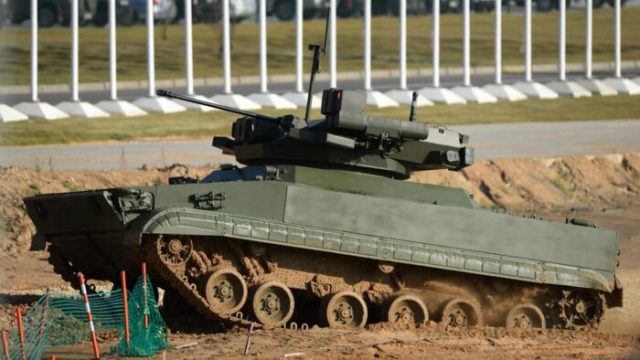
Testing of RTC "Udar"
The key problem in the development and testing of most of the Russian ground–based military robots is the lack of standardization - this problem was identified many years ago at one of the first annual conferences "Robotization of the Russian Armed Forces". Several RTK projects have been developed and tested separately from others. At the same time, there is no clear data on whether such tests really simulated a real complex combat situation.
Similarly, international sanctions against the Russian defense industry and Russian high-tech companies may affect the expansion of the necessary AI and autonomy technologies and their expansion beyond the few existing examples of RTK. The developers of the Marker claim that the RTK will enter mass production upon completion of tests in Ukraine – a potentially significant achievement in light of the huge losses of Russian military ground equipment in Ukraine and the need for the Defense Ministry to replenish its stocks with more modern equipment. At the same time, there are no signs of the previously announced acquisition by the military of the RTC "Uran-9", which may also be a sign of the stress of the military industry during the war.
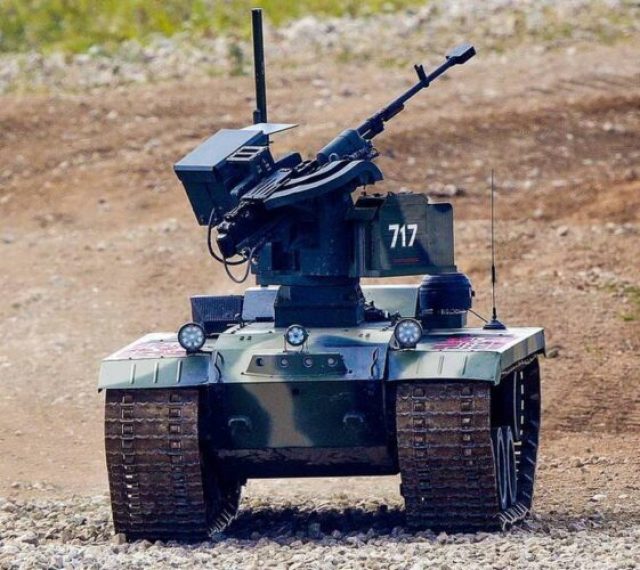
Variant of the RTC "Nerekhta" with a 12.7 mm machine gun "CORD"
Since very few Russian ground combat robots have been tested in real combat operations, it is difficult to judge the full scope of the statements of the Ministry of Defense about testing AI and autonomy in such systems. Remote-controlled RTCs seem to be more practical at this stage of the war, when they are used after securing a certain territory to clear it of mines and UXO. However, such use inevitably places operators in relative proximity to the RTK, which may endanger them if the location of the complex is tracked and attacked by Ukrainian forces.
The RTK Marker project has remained the most public example of AI and autonomy in Russia for many years, and it remains so today when Dmitry Rogozin's team announced the tests. Similar tests in Ukraine may open up the possibility for further tests of other devices. Using a military robot in combat instead of human soldiers is exactly why this technology exists. Whether the Russian military and industry will be able to cope with the task and prove that such technology is ready for combat use remains to be seen.
According to the materials of the resource euro-sd.com
